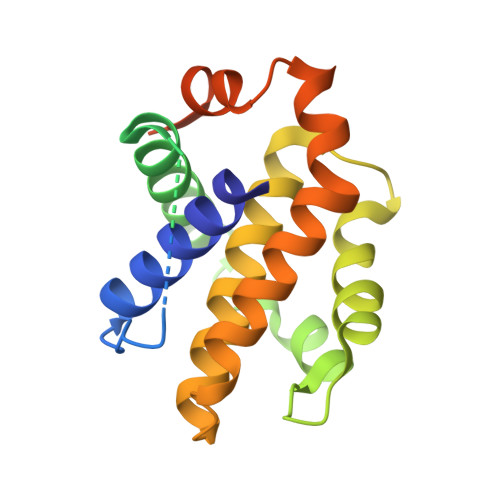A conserved hydrophobic core at Bcl-x(L) mediates its structural stability and binding affinity with BH3-domain peptide of pro-apoptotic protein
Feng, Y., Zhang, L., Hu, T., Shen, X., Ding, J., Chen, K., Jiang, H., Liu, D.(2009) Arch Biochem Biophys 484: 46-54
- PubMed: 19161970
- DOI: https://doi.org/10.1016/j.abb.2009.01.003
- Primary Citation of Related Structures:
3CVA - PubMed Abstract:
Bcl-2 family proteins regulate apoptosis through their homo- and heterodimerization. By protein sequence analysis and structural comparison, we have identified a conserved hydrophobic core at the BH1 and BH2 domains of Bcl-2 family proteins. The hydrophobic core is stabilized by hydrophobic interactions among the residues of Trp137, Ile140, Trp181, Ile182, Trp188 and Phe191 in Bcl-x(L). Destabilization of the hydrophobic core can promote the protein unfolding and pore formation in synthetic lipid vesicles. Interestingly, though the hydrophobic core does not participate in binding with BH3 domain of pro-apoptotic proteins, disruption of the hydrophobic core can reduce the affinity of Bcl-x(L) with BH3-domain peptide by changing the conformation of Bcl-x(L) C-terminal residues that are involved in the peptide interaction. The BH3-domain peptide binding affinity and pore forming propensity of Bcl-x(L) were correlated to its death-repressor activity, which provides new information to help study the regulatory mechanism of anti-apoptotic proteins. Meanwhile, as the tryptophans are conserved in the hydrophobic core, in vitro binding assay based on FRET of "Trp-->AEDANS" can be devised to screen for new modulators targeting anti-apoptotic proteins as well as "multi-BH domains" pro-apoptotic proteins.
Organizational Affiliation:
Department of Molecular Pharmacology, Shanghai Institute of Materia Medica, Chinese Academy of Sciences, 555 Zu-Chong-Zhi Road, Shanghai 201203, China.














